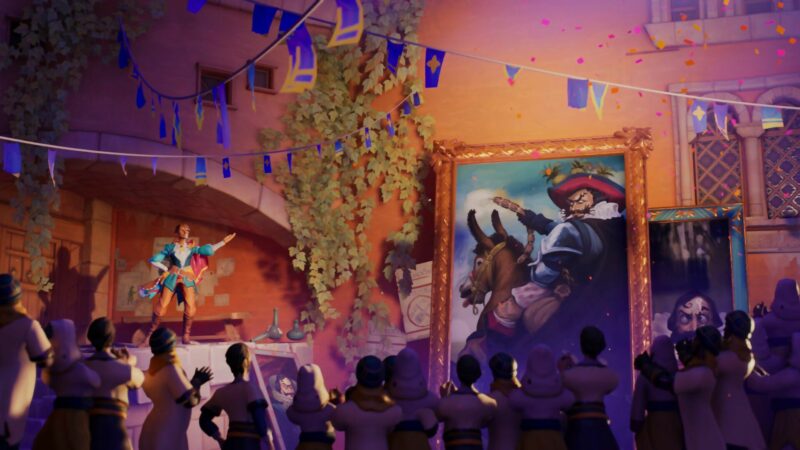
An action-adventure right out of a swashbuckler’s dream, En Garde is loaded with quippy dialogue and challenging combat to boot. Here’s our review.
When freedom is a memory and justice is outlawed, the just must become outlaws. En Garde, a swashbuckling action-adventure from Fireplace Games, feels like an interactive embodiment of this Zorro tagline, where players explore a glorious city, unravelling conspiracies and thwarting evildoers with prickly panache.
A classic heroes tale, En Garde slips you into the boots of Adalia de Volador, a quip-happy, acrobatic and endearing woman of the people who has made it her prerogative to take down The Count-Duke, a brute who cares more about his own riches and prestige than the needs of civilians. While the premise doesn’t reinvent the wheel, Firehouse has imbued En Garde with intense, dynamic combat that makes a compelling case to keep playing long after the credits have rolled.
As you wade into En Garde’s glimmering Spanish waters, you’ll find its campaign is split into four parts, giving you a taste of the city’s problems one plot point at a time. This episodic approach gives the game a novelesque feel that’s a lot of fun to unpack, even if it is a fairly straightforward method of delivery. Within each story part, you’ll face up against tricky platforming runs and challenging combat encounters, all the while finding Points of Interest that provide tidbits of contextual information that ground you in the world.
Throughout the plot, there are plenty of repeating visual gags and narrative clues to pick up on that garnered plenty of reliable chuckles, though admittedly, it was mostly Adalia’s valiant dialogue and the promise of another spectacular fight that pushed me forward in missions.
Each time you complete a level, you’ll be privy to a breakdown screen which details the time it took to complete the chapter, as well as a series of challenges to fulfil (weaken six enemies with an explosion, for example) and secrets to uncover in order to complete the level fully. Given that En Garde can be wrapped up in several hours, these extra errands are a boon for the game’s replayability and a nice touch for completionists looking for more of a challenge in the post-game.
En Garde’s most compelling feature is its engrossing swordplay. There’s a natural difficulty curve as you come to terms with its systems, and it was fantastic to feel like I was building my confidence in real-time, learning to riposte, parry and dodge to defeat enemies. En Garde demands that you string together careful inputs like a rhythm game, turning its swashbuckling into a delightful dance that increases in tempo and intensity as it introduces extra enemies and switches up its encounter design.
Much like real-life fencing, En Garde isn’t about smashing buttons but playing the enemies against the environment and making tactical considerations, coming up with a plan to defeat them (and ensuring you look good while doing so).

Credit: Fireside Games.
It’s not just about the sword, though, as Adalia is a dynamic fighter who uses almost everything at her disposal to get an advantage. This scrappy style saddles players with opportunities for mischief and theatrical mayhem. You can cut down chandeliers, throw bags of spices and light enemies on fire with lamps. Once you fill your ‘panache’ meter by pulling off these wicked stunts, you’ll also earn special attacks that can defy waves of enemies.
Outside of the main campaign, Arena Mode provides a number of additional combat situations that increase in difficulty as you complete them. Here levels aren’t as straightforward, as a system of positive and negative modifiers change how you approach each fight.
The Arena lets En Garde's strongest feature shine, letting you sharpen your sword and test your dexterity, evolving your skills to slash through whole groups of enemies with speed. After completing the main story, I spent most of my time here honing my skills, embracing my inner Inigo Montoya and crafting my own dramatic story to motivate my skilful takedowns, which was just as compelling as Adalia’s plotline. Given that the combat system is so airtight, I would have loved to see a co-op or PVP multiplayer mode implemented, allowing players to take on friends or take on the AI in groups. This feels like the next natural evolution for En Garde, as extra swords and the subsequent slapstick would really amp up the atmosphere.

Credit: Fireside Games.
There’s a reasonable array of accessibility options for players to enable in En Garde. As well as UI scaling and re-bindable keys, you’ll be able to activate invincibility, automatic parries or camera autofocus to assist you in battle, though beware, as enemies will still come at you with all they have.
Despite a lack of NPCs lining the streets, the coastal city’s vibrant villas and painterly vistas were a joy to explore, especially when cranking the graphics settings up to the max. Inspired architecture and a summer colour palette aren’t often blended with a combat system this intense, but it makes for a wonderful combination that persists through prisons and even sewage systems, the flamenco-filled soundtrack always pushing you forward.
En Garde doesn’t push the boat out with its narrative, but the world is refreshing and full of energy, which is channelled through its electric, reflex-testing combat and enchanting protagonist. This inspired indie was a delightful challenge that I couldn’t put down, even in bouts of intense frustration.

Credit: Fireside Games.
Highlight
When performing a dodge during a close call in combat, a slow-motion effect comes into play briefly that gives you a moment of breathing room to think about your next move. As combat instances start to move exceptionally fast, these windows of peace allow you to regroup and take stock of your enemies’ weak points ahead of proposing the next strike.
Verdict: 77%
En Garde manages to keep your attention with dynamic combat and platforming, even with its somewhat predictable story.








